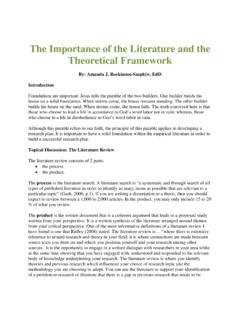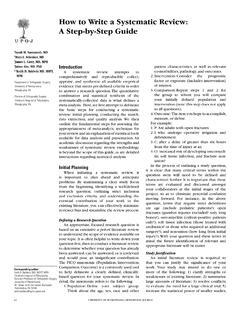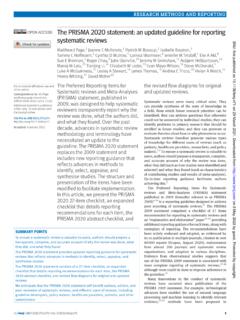Transcription of Preventing Violent Extremism Systematic Review
1 Youth Justice Board Preventing Religious Radicalisation and Violent Extremism A Systematic Review of the Research Evidence Contents About the author 3 Executive summary 4 1. Background to the Review 5 Introduction 5 Aim of the Review 5 A note on Systematic reviews 7 A note on the quality of the research evidence 7 2. Radicalisation as a process 10 Introduction 10 Models of the radicalisation process 10 The Prevent pyramid 10 The New York Police Department s four-stage radicalisation process 12 Marc Sageman s four-stage process 13 Taarnby s eight-stage recruitment process 14 Gill s pathway model 14 Wiktorowicz s al-Muhajiroun model 15 The staircase to terrorism 16 McCauley and Moskalenko s 12 mechanisms of political radicalisation 18 Summary 21 3.
2 Theories of radicalisation 23 Biological theories 23 Psychological theories 23 Muslim identity 24 Societal theories 24 Is deprivation and poor integration a direct cause of radicalisation? 24 The role of segregation and enclavisation 26 Political explanations 26 The role of social bonds and networks 27 The role of religion in the radicalisation process 28 Radicalisation incubators 30 4. Individual risk factors 31 5. Psychometric scales and assessment tools 35 The Revised Religious Fundamentalism Scale 35 The Violent Extremist Risk Assessment 35 6. Programmes tackling radicalisation 39 7. Conclusions 42 8. References of reviewed literature 44 Other references 64 Appendix 1: Detailed methodology 68 Criteria for considering studies for this Review 68 Programmes and interventions addressing radicalisation 69 Search methods for identification of studies 69 1.
3 Electronic searches 69 2. Other resources: Personal communications 70 3. Other resources: Hand searching 70 Results of the search 71 Initially included studies 71 Excluded studies 71 Total included studies 71 Data extraction exercise 72 Risk of bias in included studies 73 Effects of interventions 73 Appendix 2: Systematic Review search terms 74 Youth Justice Board for England and Wales 2012 The material featured in this document is subject to copyright protection under UK Copyright Law unless otherwise indicated. Any person or organisation wishing to use YJB materials or products for commercial purposes must apply in writing to the YJB at for a specific licence to be granted.
4 About the author Kris Christmann is a Research Fellow at the Applied Criminology Centre at the University of Huddersfield. 3 Executive summary The purpose of this Systematic Review is to examine the scholarly literature on the process(es) of radicalisation, particularly among young people, and the availability of interventions to prevent Extremism . The Review was undertaken to inform the national evaluation of the Youth Justice Board for England and Wales (YJB) Preventing Violent Extremism programmes within the youth justice system, and as such, represents one of the research outputs from that study. The full evaluation report, Process Evaluation of Preventing Violent Extremism Programmes for Young People, is to be published by the YJB alongside this Review .
5 The Review found that the evidence base for effective Preventing Violent Extremism interventions is very limited. Despite a prolific output of research, few studies contained empirical data or Systematic data analysis. Furthermore, although a growing body of literature investigating the radicalisation process is emerging, the weight of that literature is focused upon terrorism rather than radicalisation. As such, the evidence is concerned with that smaller cohort of individuals who, once radicalised, go on to commit acts of violence in the pursuit of political or religious aims and objectives. This introduces a Systematic bias in the literature , away from the radicalisation process that preceeds terrorism, including radicalisation that does not lead to violence.
6 Despite these limitations, the Systematic Review found that Islamic radicalisation and terrorism emanate from a very heterogeneous population that varies markedly in terms of education, family background, socio-economic status and income. Several studies have identified potential risk factors for radicalisation, and, among these, political grievances (notably reaction to Western foreign policy) have a prominent role. The Review found only two evaluated UK programmes that explicitly aimed to address Islamic radicalisation in the UK. These were outreach and engagement projects running in London: the Muslim Contact Unit (MCU) and the Street Project.
7 In addition, the Review drew heavily upon the Department for Communities and Local Government s (DCLG) rapid evidence assessment, Preventing Support for Violent Extremism through Community Interventions: A Review of the Evidence (Pratchett et al, 2010). This advocated the adoption of capacity building and empowering young people, and interventions that challenge ideology that focus on theology and use education/training . The Netherlands-based Slotervaart Project was identified as an exemplar of the outreach/community-based approach recommended by the DCLG Review . The Review also considered a number of de-radicalisation programmes operating in several Islamic countries and programmes tackling right-wing radicalisation.
8 These programmes provide some potential learning points for future UK programmes, chiefly around the need for those engaging with radicalised individuals to carry authority and legitimacy, and to be equipped with profound ideological knowledge. 41. Background to the Review Introduction The suicide attacks on London in July 2005 and Madrid in March 2004 have brought recognition from many government, academic and security sources that Europe now confronts a qualitatively different kind of terrorism . What has been described as the new terrorism appears to function across a global dimension, while being more fluid, dispersed and unpredictable than previous terrorist threats.
9 New terrorism is conducted by largely autonomous groups which operate in the absence of institutional training and recruitment, but share an ideological affinity with the original Al Qa ida network, and are defined ethnically and racially. It has been argued that the emergence of these networked self-starter cells represents a distinct and novel phenomenon and a dramatic departure from previous activity. The London attacks, in which 52 people were killed, also signalled another tendency, that the perpetrators were all citizens who had spent the majority, and sometimes all, of their lives in the UK. These were not then hardened veterans of some former conflict, but rather disenfranchised members of a community who would have been moulded in a broadly liberal-democratic and tolerant multi-cultural context.
10 Yet, as many commentators have noted, such assumptions hardly seem credible when considering the values that the militant ideologues espoused in martyrdom videos and the obvious indifference to mass civilian casualties. Of course there is nothing new about religious violence, political violence, or its more familiar label of terrorism . Neither have governments been slow to brand Violent opponents with this title, nor to produce ever more proscriptive legal definitions of terrorism, most of which encompass behaviour that would constitute offences under ordinary criminal law (Townsend, 2002: 3). The radicalisation of European Muslims is now a focal point of research and political debate on contemporary Al Qa ida-influenced terrorism in Europe.

















